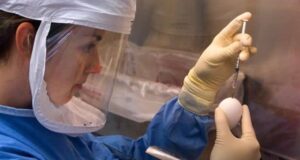
In the holiday movie The Grinch, makeup artists are reported to have spent several hours each day encasing Jim Carrey’s face with prosthetics to create the iconic grumpy, green-furred creature. Such elaborate prosthetics, often made possible by materials like silicone rubbers, may have now found an unexpected yet beneficial biomedical engineering application, according to a new study from Texas A&M University.
Published in the journal Scientific Reports, researchers have created realistic, skin-like replicas made of Ecoflex, a type of silicone rubber that can potentially serve as a platform to evaluate risks of bacterial infections from intravenous catheters and test wearable sensors, among other biomedical applications. The study found that EcoFlex-based skin replicas can be engineered to mimic actual skin textures, wettability, and elasticity, simulating the conditions where bacteria grow and adhere.
We think that the material holds tremendous promise for studying infections at the insertion site due to bacteria that are naturally occurring on the skin. Our goal was to create a skin-like material with ingredients that can be purchased off the shelf. Ecoflex is not just easy to use, it can be cured quickly with minimum additional steps, making it very convenient.”
Majed Othman Althumayri, graduate student in the Texas A&M Department of Biomedical Engineering and primary author of the paper
There are roughly a million bacteria per square centimeter of human skin. The most common of them is Staphylococcus, particularly the species Staphylococcus epidermidis, which is considered a typical resident of the skin microbiome. Infections often happen when there is a cut, break or wound on the skin, allowing the bacteria to enter the bloodstream. In fact, a relatively common infection in hospitals comes from surgically inserting tubes or catheters into veins. Each year, around 80,000 catheter-related bloodstream infections happen in intensive care units alone, underscoring its public health significance in the United States.
“We have been slow in finding solutions for preventing infections from intravenous catheters,” said Althumayri. “A reason could be that we lack good platforms to test new catheter designs or wearable biosensor technologies and train staff so that the number of infections can be reduced.”
To address this gap, the researchers turned to Ecoflex 00-35, a fast-curing, biocompatible rubber used for various applications, including prosthetics for special effects. First, they created molds of common intravenous insertion sites, such as the elbows, hands and forearms. Then, by pouring Ecoflex into the molds that contained artificial bones and tubes acting as veins, the researchers created skin-like replicas.
Next, the researchers tested if the Ecoflex skin replicas had properties that matched that of real skin. They measured the replicas’ wettability, bacterial adhesion and mechanical properties, such as elasticity and resilience. The researchers found that the Ecoflex models could replicate human skin roughness within a 7.5% error margin. Further, high-resolution imaging showed that bacteria could adhere to the skin replica and grow on it.
Then, in a key experiment, the researchers simulated an intravenous catheter insertion into an Ecoflex hand replica that they created. This artificial hand effectively modeled phases of bacterial growth, showing promise that these replicas can be used for implementing infection control measures and improving the design of medical devices like catheters.
However, the researchers noted that their current experiments do not entirely model real-world conditions.
“Developing realistic skin models that can mimic the human skin is an important initial step,” said Dr. Hatice Ceylan Koydemir, corresponding author on the study and assistant professor in the Department of Biomedical Engineering with a research program housed within the Texas A&M University Center for Remote Health Technologies and Systems. “But we think that incorporating additional elements, like body fluids and other clinically relevant situations, in future experiments will bolster our findings and further validate Ecoflex’s potential for medical applications.”
Other contributors to the research include Azra Yaprak Tarman, a graduate student in the Department of Biomedical Engineering.
This study was partly sponsored by the National Institute of General Medical Sciences (one of the National Institutes of Health), the Department of Defense Office of Naval Research and the National Science Foundation-funded Engineering Research Center PATHS-UP. Researchers also received additional support from the Department of Biomedical Engineering, the Center for Remote Health Technologies and Systems, the Texas A&M Engineering Experiment Station, the AggieFab Nanofabrication Facility, and the Soft Matter Facility.
Source:
Journal reference:
Althumayri, M. O., et al. (2024). Bioinspired skin-like in vitro model for investigating catheter-related bloodstream infections. Scientific Reports. doi.org/10.1038/s41598-024-76652-y.




